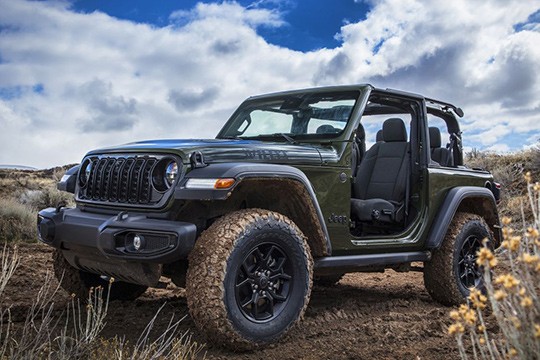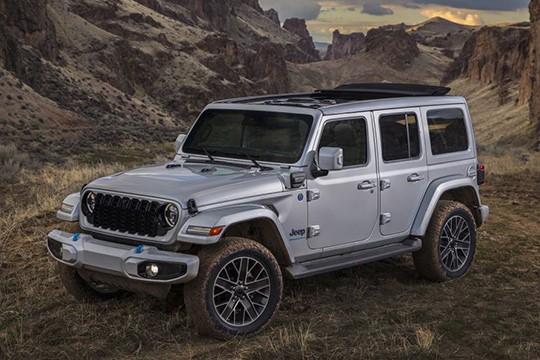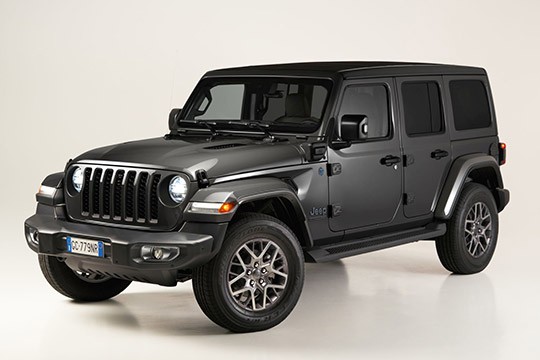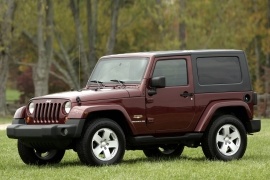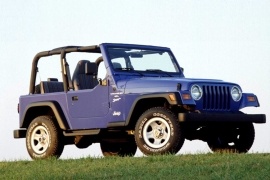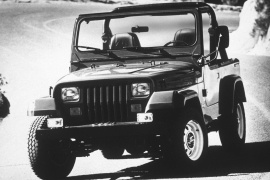JEEP Wrangler Models/Series Timeline, Specifications & Photos
First production year: 1986
Engines: Gasoline, Plug-in hybrid, Hybrid gasoline, Diesel
Body style: SUV (Sports Utility Vehicle)
Based on the same sturdy chassis of the Wrangler JL, the 2024 Willys version was a nice surprise for the American automaker, which also came with a locking differential for the rear axle.
Jeep never abandoned its heritage and also bragged about its connection with the Willys. This sturdy 4x4 car helped the Allies win WWII. Over the years, even the styling of the Wrangler lineup resembled that vehicle, and apart from one generation, all others featured round headlights, for instance. In 2023, at the Easter Jeep Safari and at the NYIAS, the carmaker introduced the 2024 model year of the Wrangler Willys.
Like the rest of the Wrangler range, the Willys featured the new, smaller grille, which was integrated into the body-colored front panel. On the sides, the round headlights were pushed furthermore inside the bodywork and thus were protected by branches, bushes, and other off-road-specific obstacles. On its sides, the 33" tires were new.
The interior was heavily upgraded with a new 12" landscape-mounted touchscreen for the infotainment system. This Connect 5 unit replaced the former 8" one and also featured Apple CarPlay and Android Auto.
The drivetrain was also improved with a Tru-Lok rear locking differential that was highly demanded by customers. In addition, the 4xe powertrain version came with the Selec-Trac full-time transfer case that added a low-range 2.71:1 ratio.
Jeep introduced a new 2024 Wrangler at the Easter Jeep Safari, at the same time as the unveiling at the 2023 NYIAS, and the 4xe version was one of the most sought-after versions of this well-known off-roader.
When the American automaker introduced a plug-in version of the Wrangler in 2021, customers were stunned. It was difficult to believe that a BEV could cope with off-road situations. Still, the vehicle proved its worthiness, and it became the best PHEV in America for two years in a row.
For the new model, based on the JL Wrangler, the 4xe version came with a redesigned front fascia. This included a smaller seven-slat grille incorporated in a body-colored panel. That was flanked by deep-dish LED headlights, which were better protected against bushes, branches, and other off-road situations. In addition, the 4xe featured blue anchoring hooks at the new, redesigned bumper. The carmaker offered as an option a factory-mounted Warn winch. Another upgrade for the car was the deletion of the aerial antenna, which was traditionally mounted on the right side of the vehicle. That was moved into the windshield. A 4xe-specific feature was the outlet plug that was placed on the left-rear quarter panel. Thus, the car could power various camping appliances, and the engine could be transformed into a gas-powered generator.
The interior was heavily upgraded with a new 12" landscape-mounted touchscreen for the infotainment system. This Connect 5 unit replaced the former 8" one and also featured Apple CarPlay and Android Auto. Unlike previous Wrangler models, the 2024 version featured power seats and lumbar adjustments for both front occupants. In the four-door (Unlimited) version, the 4xe came with a flat-folding bench fit for three. With that folded down, owners could transform the vehicle into a camper.
There were no significant changes on the engine side, but the Dana 44 axle was an improvement. Moreover, it was also provided with a locking differential.
When Jeep introduced the 2024 Wrangler, the Rubicon 4xe version was also unveiled, showing the world that a hybrid vehicle can also perform outstandingly in off-road situations.
The Rubicon version is one of the few cars in the world that could be taken straight from the showroom floor to a very difficult off-road trail and go through it without breaking a sweat. But the 2024 Rubicon 4xe can do more than that. It can silently go through a city with zero emissions at its tailpipe, thanks to the electrified drivetrain.
Sporting the same smaller front fascia as its siblings, the Rubicon 4xe also carried over the blue tow-hooks characteristic for the plug-in hybrid version. Unlike the regular 4xe, this hard off-road vehicle featured a new front bumper designed to host an 8,000 lbs Warn winch. Furthermore, the 33" BFGoodrich All-Terrain tires were fitted as standard. Like the rest of the Wrangler lineup fitted with the plug-in hybrid drivetrain, this version was also equipped with a V2L system that allowed users to provide electricity for a camper or other appliances.
Inside, there were massive upgrades compared with its predecessor. Atop the center stack, the automaker installed a 12" touchscreen for the Uconnect 5 infotainment system. But Jeep also focused on customers' comfort and added power seats. Along with the new lineup, the Rubicon also got adaptive cruise control, side airbags, and blind spot monitor. As a final detail, this version featured blue Rubicon lettering embroidered on the seatbacks' fronts.
Powered by a four-cylinder mill and an electric motor incorporated into the gearbox, the Rubicon 4xe proved that a PHEV can also forge through water, mud, and other difficult situations. Its locking differentials and the free-floating axle were part of the model 2024 upgrades.
While it wasn't the first hybrid 4x4 vehicle on the market, the 2021 Wrangler 4xe (spelled four-by-e) promised actual off-road performance and high fuel efficiency.
Jeep continued the Wrangler saga, and, despite being offered a choice of diesel and gasoline engines, it managed to implement a plug-in hybrid system for the well-known off-road vehicle. The most challenging part was to keep its legendary off-road attributes while still being environmentally friendly. For that, it mounted a nickel-manganese-cobalt battery pack under the rear seats and protected them in a sturdy aluminum case.
At a glance, it was easy to spot a 4xe from the rest of the Wrangler range due to its charging port on the left side of the vehicle, at the bottom of the windshield. The Rubicon version featured blue tow-hooks both front and rear.
Inside, the car was very similar to the rest of the Wrangler range, but with a few different buttons for the plug-in hybrid system. Also, on top of the center stack, a special lamp with integrated blue LEDs showed the charging status without the need for a designated app.
The drivetrain was the most significant part of the car with its dual-motor system. Under the hood, a starter-generator helped the turbocharged inline-four gasoline engine. Jeep integrated the second electric motor into the eight-speed automatic transmission supplied by ZF. From there, the hybrid system sent the torque to the wheels via a usual Jeep 4x4 system. Like its siblings, the 4xe featured a front and solid rear axle.
In 2018, Jeep launched the fourth generation of the Wrangler, available with either two or four doors and, most importantly, with the Rubicon version meant for serious off-roading.
Jeep had enough jokes about its hard-core product, the Wrangler, and took a decisive step when making the Rubicon version. Thus, it offered an off-road vehicle that could tackle any kind of rough terrain right from the showroom's floor. And that was not an overstatement.
It was just normal to see the Wrangler with a similar look to its predecessors. Yet, the entire vehicle was new from tip to toe and from nose to tail. But a keen eye for detail could have noticed some subtle modifications. At the front, the windshield was tilted more than on its predecessor, and the car sported LED headlights and fog lamps. In addition, the rounded shapes were a clear statement of evolution. From its profile, the exposed hinges and the high ground clearance were also a signature mark for the Rubicon as it was the seven-slat grille for the Jeep brand.
While the exterior featured subtle changes, the interior was an important evolution. There were much nicer materials inside the Rubicon Unlimited. Jeep even offered an option for a leather-wrapped dashboard. Yet, the bucket seats at the front and the narrow, flat bench in the rear didn't provide any side support. The driver could enjoy the start-button feature and a mix of digital and analog instrument panels that provided all the information needed while driving.
Just like its predecessors, the Wrangler relied on a sturdy chassis. Its stabilizer bars could've been disengaged for higher axle mobility. Moreover, the front and rear diff-locks were fitted as standard on the Rubicon version. Under the hood, Jeep installed a choice of three engines: a 3.6-liter V6, a 2.0-liter turbocharged gasoline unit carried over from Fiat, and a 3.0-liter turbo-diesel.
At the 2006 North American International Autoshow, Jeep unveiled the third generation of the Wrangler, known as the JK, which came with significant upgrades over its predecessor, including a five-door bodywork.
Continuing an iconic vehicle without spoiling it while improving the model wasn’t easy. Many other automakers tried and failed spectacularly. Jeep already experienced that with the Cherokee lineup and didn’t want to risk anything with the Wrangler. As a result, when the American brand unveiled the Gladiator concept car in front of the public at the 2005 Detroit Auto Show, it watched customers’ reactions, and the results were positive: the beloved offroader was on the right path. Then, in 2006, the moment of truth came, and Chrysler’s CEO Tom LaSorda entered the stage after it climbed some stairs and stormed through a glass wall. The idea wasn’t new, and it was previously used by Bob Lutz when he launched the 1992 Grand Cherokee lineup, but the effect was similar. But, unlike the famous entrance, the new one was eagerly awaited by customers, even though, at first sight, it looked identical.
While the Wrangler JK featured round headlights and a seven-slat grille as its predecessor, it was a completely new vehicle. Not a single panel was carried over from the TJ version. Its headlights were slightly recessed, while a set of round turn signals were mounted underneath them. This was new, and customers didn’t expect it, albeit appreciated. Furthermore, the bumper was longer and sported a plastic cover that made it look like a sitting bench. The newest safety standards required pedestrian protection, and the previously used steel one couldn’t provide it.
From its profile, the two-door Wrangler JK had exposed door hinges like those of its predecessors, but the door handles were completely new. Instead of the high-mounted, flush-to-bodywork ones, it had grab handles with big and round buttons to open them. They could be easily operated with gloves. On the outer edges of the front fenders, the automaker installed small blinkers, solving a legal safety-related issue. The bulky door mirrors were left unpainted and mounted on a mechanism that could fold them quickly without damaging them. Like all the Wranglers before it, the JK was available with a removable, plastic hard top with side windows and removable individual panels above the driver and the side passenger. That was a first for the car. At the back, a pair of rectangular, vertical taillights flanked the side-hinged door, which sported the spare wheel mounted on a reinforced cradle.
The cabin continued the idea of a modular design, with a center stack that housed the new infotainment system with satellite navigation, a CD player, and a USB port, depending on the market. Lower grades, on the other hand, were fitted with a basic stereo. Fronting the driver was a fresh instrument cluster that showed just the dials for the speedometer and tachometer, as well as the gauges for the fuel level and coolant temperature. The automaker considered that the rest of the gauges weren’t needed. Thanks to the two-inch (5 cm) longer wheelbase than the one offered on the TJ generation, there was slightly more room in the back for two adults, albeit not suitable for long travels.
Under the hood, the most significant novelty was the introduction of a 2.8-liter turbodiesel, which proved to be effective, fuel-efficient, and snappy enough for its customers. Jeep ditched the previous 2.5-liter gasoline engine. All versions were available with either a six-speed manual or a four-speed automatic.
While the rest of the Wrangler JK range could be excellent companions for school runs and drives around towns, the Rubicon was among the best off-road vehicles available.
The launch of the Wrangler generation started a new chapter in the nameplate’s history. Not only was it the first of its kind available in a five-door configuration, but it was also fitted with the best available off-road dedicated parts and features. The reinforced transmission, the larger wheels, and the higher power transformed the regular Wrangler into an off-road beast able to pass over the most difficult obstacles met on a trail in the woods. Jeep didn’t design the Rubicon alone. It asked enthusiasts, spare parts partners, and specialists. As a result, the car came fitted with all the necessary equipment so it could go through some of the most difficult off-road trails right off the showroom floors. Its short wheelbase, heavy-duty axles, and mind-boggling low-range gear transformed the vehicle into a serious contender against vehicles such as the G-Class and the Land Cruiser. Last but not least, it was fitted with all the required amenities to make it a comfortable urban vehicle.
There was something about the car’s front fascia that made it look slightly different than its stablemates. There was a gap that separated the wheel arches from the front bumper, and the ground clearance was obviously higher, thanks to the larger wheels. In addition, the automaker installed the fog lamps closer to the vehicle’s center, not below the headlights, like its siblings. Still, the recessed headlights, the tilted-rearward seven-slat grille, and the round turn signals were shared with the rest of the Wrangler range.
From its profile, the higher ground clearance became even more obvious, resulting in a taller vehicle stance. Instead of side steps, it featured a set of skid bars, which protected the bodywork when the car was rock-crawling. The black door mirrors and door handles were similar to the rest of the Wrangler JK range. Out back, the gap between the wheel arches and the tires was big enough to allow the long-travel suspension to do its work. Behind them, the automaker placed the fuel-filler cap in a black plastic surrounding. The back of the vehicle sported a side-hinged door and a cradle, which supported the spare wheel. Like the rest of the range, the Wrangler Rubicon was available with a modular removable hard top, and it could be driven with the doors off and the windshield folded while the passengers were protected by the heavy-duty roll cage.
The cabin looked similar to the rest of the Wrangler range, featuring a modular plastic dashboard. Its instrument cluster was filled with large dials for the speedometer and the rev counter, as well as smaller gauges for the fuel level and the coolant temperature. Besides the stereo, the center stack also housed the buttons that could lock the axles and disengage the stabilizer bar. Between the front occupants, on the center console, the automaker placed the gear stick (or the gear selector of the automatic transmission, depending on the option) and the lever for the transfer case. Like in any other three-door Wrangler, the rear passengers didn’t have too much legroom despite the two-inch (5 cm) longer wheelbase compared with the Wrangler TJ.
Under its skin, the Rubicon was a different kind of off-road beast. Its Dana 44 heavy-duty axles with locking front and rear differentials were specific for the model. It also featured a 4.0:1 low-range gearing, which was unique on the market. Its non-Rubicon sibling had a 2.7:1 gearing. Power came from a 3.8-liter V6 gasoline unit or a 2.8-liter turbodiesel supplied by VM Motori, depending on the market.
Jeep introduced the second generation of the Wrangler in 1996, and unlike its predecessor, it was controlled by the American car company Chrysler.
When the previous generation broke covers in 1986, Jeep and AMC were still owned by the French automaker Renault. The model was successful, with more than 600,000 units sold in a decade, but it was not considered a true successor of the Willy’s or the CJ5/7 due to its squared headlights. However, after Renault dropped the towel on the American market and sold AMC and Jeep to Chrysler in 1987, the new owner considered improving the Jeep brand. Furthermore, it listened carefully to what owners wanted, and then it delivered the second generation of the Wrangler, the TJ, in 1996 for the 1997 model year.
Chrysler introduced the Wrangler TJ at the North America International Auto Show in Detroit in 1996, and customers were happy with the new round headlights, which replaced the squared ones from the YJ Wrangler. Between them, the automaker placed the classic seven-slat grille. Jeep installed squared turn signal lamps on the wide front fenders, while the bumper featured rubber caps on its ends.
From its profile, the windscreen grabbed attention. It was still flat and could fold forward onto the hood, but its base was moved two inches forward, and its overall height was one inch shorter than on the YJ, resulting in a slightly better drag coefficient. Another improvement was for the fuel cap, which was moved to the rear quarter panel on the driver’s side. The wheel fenders were adorned by rubber trims, which protected the bodywork against chips and stones thrown from the wheels. A set of side steps eased ingress and egress to the cabin. Out back, the automaker installed a side-hinged half-door that allowed access to the trunk and supported the spare wheel as well.
The cabin was a big step forward in terms of comfort and features. Fronting the driver was an instrument cluster that grouped all the main dials and gauges on the same panel, unlike its predecessor, which had them spread on the dashboard towards the side passenger. In addition, the modular dashboard allowed for lower production costs for LHD and RHD vehicles. On the center stack, Jeep installed the stereo cassette player and the HVAC control unit, while on the center console, it placed the gear stick and the lever for the transfer box. The redesigned front bucket seats provided more comfort and could slide forward to ease access for those seated in the back.
Under the hood, the Wrangler TJ was available with a choice of two engines: a 2.5-liter inline-four and a four-liter inline-six paired with a five-speed manual or, as an option, a three-speed automatic. Later, a four-speed automatic replaced the three-speed version.
AMC owned the Jeep brand since 1970, when it acquired the Kaiser Jeep Corporation. It produced the CJ (Civilian Jeep) until 1986 when it replaced it with the brand-new Jeep Wrangler.
Despite being one of the most produced off-road vehicles in history, the CJ had already started to show its wrinkles and limits. It has been in production in various forms and with several upgrades since 1944. Its high center of gravity and on-road behavior were no longer appreciated by customers. Then, after AMC was bought by Renault in 1979, the American automaker grew exponentially, especially thanks to the Cherokee lineup, which was introduced in 1984. But while that revolutionary SUV became the darling of many families, the adventure-oriented two-door CJ was not. As a result, the car manufacturer replaced it with the Wrangler YJ in 1986 for the 1987 model year. It came with significant upgrades, and many of its underpinnings were carried over from its bigger siblings, the Cherokee and the Wagoneer. Success followed, and Jeep sold almost 700,000 units of the Wrangler YJ between 1986 and 1996, when it was replaced by the TJ.
Jeep wanted to make a clear, easy-to-see distinction between the CJ and the YJ. One of the easiest ways to achieve that was to install rectangular headlights instead of the round ones offered by its predecessor. In addition, the seven-slat grille was not straight-up but slightly tilted rearward. Its metallic front bumper was still pushed forward, thus protecting the bodywork from bushes and other off-road obstacles. In addition, the wide fenders sat lower than the hood and sported turn signals on the sides.
From its profile, the Wrangler was easy to recognize as a genuine Jeep, especially with the available hard top removed. Its flat body panels and low-cut doors fitted with flush door handles were Jeep-specific. Like its predecessor, it could be driven without the doors and with the windshield folded down, tightened on the hood by special mounts. Out back, instead of the fold-down tailgate, it sported a side-hinged one, which also supported the spare wheel. The automaker offered the vehicle a folding roof that could be retracted behind the rear seats or left behind at home, as well as a removable hard top fitted with side and rear windows. As a result, customers were better protected against bad weather. The rear window was hinged on its upper side and could be tilted to ease loading and unloading the tiny trunk.
One of the most significant upgrades was found inside the vehicle. The cabin was fitted with a steel roll cage, protecting occupants in the event of a rollover crash. AMC had to pay millions of dollars in compensation due to such accidents for the CJ, and this was the ideal solution that it came with. Due to this safety device, it had to install slimmer front seats with integrated headrests that could slide forward to ease ingress and egress for the rear passengers. The dashboard was no longer a painted steel plate, as in the CJ, but a modern-looking dashboard filled with dials and gauges. Between the front occupants, the automaker installed a floor-mounted gear stick and the lever for the transfer box, which featured a shift-on-the-fly system for the 4x4 system. Drivers didn’t need to stop to switch from 2WD to 4WD, although they had to stop if they wanted to engage the low-range gear. In the back, the automaker placed a folding bench seat for two. Due to the short wheelbase of the vehicle, only the driver had enough legroom, while the side passenger had some trouble with the grab-handle in front of them, and the rear ones had minimal area between the rear seats and the front ones.
Under the hood, the base Wrangler YJ came with a single-point fuel-injected inline-four 2.5-liter engine, while the top-spec version featured a 4.2-liter carbureted inline-six powerplant. Later, these engines were upgraded to multi-point fuel injection systems. A 4.0-liter straight-six engine replaced the 4.2-liter unit in 1991. Between 1987 and 1991, AMC paired the engines with either a five-speed manual or a three-speed automatic, depending on the engine version.
